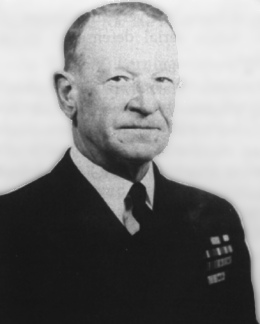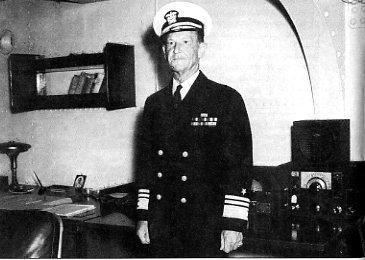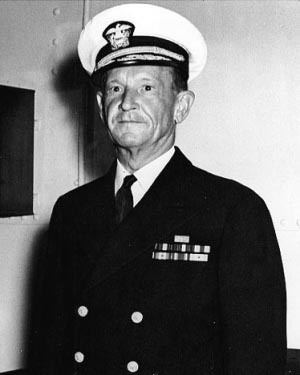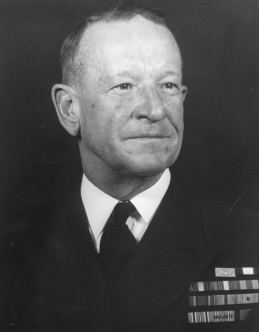Years of service 1906-1947 | Rank Admiral Name Frank Fletcher | |
 | ||
Battles/wars Mexican Revolution–Battle of VeracruzWorld War I–Battle of the AtlanticWorld War IIBattle of the Coral SeaBattle of MidwayGuadalcanal campaignBattle of Tulagi and Gavutu-TanambogoBattle of the Eastern Solomons Similar People Raymond A Spruance, Chuichi Nagumo, Chester W Nimitz, Nobutake Kondo, William Halsey - Jr | ||
Admiral frank jack fletcher
Frank Jack Fletcher (April 29, 1885 – April 25, 1973) was an admiral in the United States Navy during World War II. Fletcher was the operational commander at the pivotal Battles of Coral Sea and of Midway. As a lieutenant, Fletcher was awarded the Medal of Honor for his actions in battle at Veracruz. He was the nephew of Admiral Frank Friday Fletcher, who was also awarded the Medal of Honor for actions at Veracruz.
Contents
- Admiral frank jack fletcher
- Early life and early Navy career
- World War I and post war period
- Interwar service
- Pearl Harbor
- Wake Island December 823 1941
- JanuaryApril 1942
- Coral Sea May 48 1942
- Midway June 47 1942
- Landing at Guadalcanal August 79 1942
- East Solomons August 2425 1942
- Northern
- Postwar and final days
- Awards
- Medal of Honor citation
- Legacy
- References

Early life and early Navy career

Fletcher was born in Marshalltown, Iowa, on April 29, 1885. Appointed to the US Naval Academy from his native state in 1902, he graduated from Annapolis on February 12, 1906, served two years at sea, then required by law, and commissioned as an Ensign on February 13, 1908.

Following graduation from the Naval Academy in 1906, he served in battleships Rhode Island and Ohio, operating in the Atlantic. After a year in Eagle on special service, he reported to Maine, of the Atlantic Fleet in December 1908. In August 1909, he was assigned to Franklin, his duty drafting men for the Pacific Fleet and transporting them on board Tennessee to Cavite.

In November 1909, he was assigned to the destroyer Chauncey, operating as part of the Asiatic Torpedo Flotilla. Fletcher assumed command of the destroyer Dale in April 1910, and in March 1912, he returned to Chauncey as her commanding officer. In December 1912, he was transferred to the battleship Florida. In April 1914, he was aboard that battleship, the flagship of his uncle Frank Friday Fletcher, during the occupation of Veracruz, Mexico. He was awarded the Medal of Honor for the rescue of refugees on the transport Esperanza.

Detached from Florida in July 1914, he served briefly in Tennessee before reporting as Aide and Flag Lieutenant on the staff of the Commander in Chief, US Atlantic Fleet in July 1914. After a year at this post, he returned to the Naval Academy for duty in the Executive Department.
World War I and post-war period

Upon the outbreak of World War I he served as gunnery officer of Kearsarge until September 1917, after which he assumed command of Margaret. He was assigned to Allen in February 1918, before taking command of the destroyer Benham in May 1918.
For
distinguished service…as Commanding Officer of the USS Benham engaged in the important, exacting and hazardous duty of patrolling the waters infested with enemy submarines and mines, in escorting and protecting vitally important convoys of troops and supplies through these waters, and in offensive and defensive action, vigorously and unremittingly prosecuted against all forms of enemy naval activity,
he was awarded the Navy Cross.
From October 1918 to February 1919, he assisted in fitting out the destroyer Crane at the Union Iron Works, San Francisco, but was detached before her commissioning. He then had similar duty with Gridley, also building there, and upon her commissioning on March 8, 1919, assumed command. He was relieved of that command in April 1919. Returning to Washington, he was head of the Detail Section, Enlisted Personnel Division in the Bureau of Navigation until September 1922.
Interwar service
He returned to the Asiatic Station, having consecutive command of Whipple, Sacramento, Rainbow, and the submarine base at Cavite. Returning to the United States, he served at the Washington Navy Yards from March 1925 to 1927; became executive officer of the battleship Colorado; and completed the Senior Course at the Naval War College, Newport in 1929–30, followed immediately by the Army War College in Washington, D.C., 1930–31, in preparation for strategic leadership responsibilities.
Fletcher became chief of staff to the Commander in Chief, US Asiatic Fleet in August 1931. In the summer of 1933, he was transferred to the Office of the Chief of Naval Operations. Following this assignment he had duty from November 1933 to May 1936, as aide to the Secretary of the Navy, the Honorable Claude A. Swanson.
He assumed command of the battleship USS New Mexico, flagship of Battleship Division Three, in June 1936. In December 1937, he became a member of the Naval Examining Board, and became Assistant Chief of Bureau of Navigation in June 1938. Returning to the Pacific between September 1939 and December 1941, he became Commander Cruiser Division Three; Commander Cruiser Division SIX; Commander Cruiser Scouting Force; and Commander Cruiser Division Four.
Pearl Harbor
He was serving as Commander Cruiser Division Four when the Japanese attacked the Naval Base at Pearl Harbor on December 7, 1941. He became Commander Cruisers, Scouting Force, with additional duty as Commander Cruiser Division Four, on December 31, 1941. Here he was in command of one of the two Task Forces participating in operations in the Marshall-Gilbert Islands in the February 1942, and the following month was second in command in the Salamaua-Lae operations.
Wake Island: December 8–23, 1941
Responding to reports from US Marines on Wake Island of Japanese bombardment and a subsequent invasion attempt in the first week after Pearl Harbor, Fletcher was sent west with the aircraft carrier Saratoga (Task Force 11) to provide relief. He was one day away when plans were changed and ordered to wait for Lexington (Task Force 12, Vice Admiral Wilson Brown). The next day the Japanese successfully invaded Wake Island. The task force was recalled by Admiral William S. Pye, who was "keeping the seat warm" until Admiral Chester W. Nimitz could arrive at Pearl and take over as Commander-in-Chief, Pacific Fleet.
January–April 1942
On January 1, 1942, Rear Admiral Fletcher took command of Task Force 17 built around the carrier Yorktown. He, a surface fleet admiral, was chosen over more senior officers to lead a carrier task force. He learned air operations on the job while escorting troops to the South Pacific. He was junior TF commander under tutelage of the experts: Vice Admiral William Halsey during the Marshalls-Gilberts raids in February; Vice Admiral Wilson Brown attacking the enemy landings on New Guinea in March; and had aviation expert Rear Admiral Aubrey Fitch with him during the first Battle of the Coral Sea.
On April 19, 1942, he was designated Commander Cruisers, Pacific Fleet, with additional duty as Commander Cruiser Division Four.
Coral Sea: May 4–8, 1942
In May 1942, he commanded the task forces during the Battle of the Coral Sea. This battle is famous as the first carrier-on-carrier battle fought between fleets that never came within sight of each other.
Fletcher with Yorktown, Task Force 17, had been patrolling the Coral Sea and rendezvoused with Rear Admiral Aubrey Fitch with Lexington, Task Force 11, and a tanker group. Fletcher finished refueling first and headed West. On hearing the enemy was occupying Tulagi, TF 17 attacked the landing beaches, sinking several small ships before rejoining Lexington and an Australian cruiser force under Rear Admiral John Gregory Crace on May 5.
The next day, intelligence reported a Japanese invasion task force headed for Port Moresby, New Guinea, and a Carrier Strike Force was in the area. The morning of May 7, Fletcher sent the Australian cruisers to stop the transports while he sought the carriers. His combat pilots sank the Japanese aircraft carrier Shōhō, escorting the enemy troop ships — "Scratch one flat top." radioed Lieutenant Commander Robert Dixon flying back to Lexington. That same day, Japanese carrier planes of Rear Admiral Chuichi Hara found the American tanker Neosho. Believing they had found a carrier, they severely damaged her after several all-out attacks, and sank her escorting destroyer, Sims; on May 11, Henley located her, rescued the surviving crew, and sank her by naval gunfire.
On May 8, at first light, "round three opened." Fletcher launched seventy-five aircraft, Hara sixty-nine. Fitch had greater experience in handling air operations, and Fletcher had him direct that function, as he was to do again later with Noyes at Guadalcanal. Shōkaku was hit, but not damaged below waterline; it slunk away. Zuikaku had earlier dodged under a squall. The Japanese attack put two torpedoes into Lexington, which was abandoned that evening. Yorktown was hit near her island, but survived. Hara failed to use Zuikaku to achieve victory and withdrew. The invasion fleet without air cover, also withdrew, thereby halting the Port Moresby invasion. Fletcher had achieved the objective of the mission at the cost of a carrier, tanker, and destroyer. In addition, his "Wildcats" had beaten Japanese air groups, 52 to 35, and had damaged Shōkaku; neither Japanese carrier would be able to join the fight at Midway the following month.
This was the first World War II battle in which the Imperial Japanese Navy had been stopped. In battles in Pearl Harbor, East Indies, Australia and Ceylon, they had defeated the British, Dutch, and Asiatic Fleets, and had not lost a fleet ship larger than minesweepers and submarines.
Midway: June 4–7, 1942
In June 1942 Fletcher was the Officer in Tactical Command at the Battle of Midway with two task forces, his usual TF 17 with quickly repaired Yorktown, plus TF 16 with Enterprise and Hornet. Vice Admiral William Halsey normally commanded this task force, but became ill and was replaced by Rear Admiral Raymond Spruance. When aircraft from four Japanese carriers attacked Midway Island, the three US carriers, warned by broken Japanese codes and waiting in ambush, attacked and sank three enemy carriers – Akagi, Kaga, and Sōryū. Enterprise and Hornet lost seventy aircraft. Japanese attacks on June 4 severely damaged Yorktown; repairs returned her to the battle until she was hopelessly disabled by a new round of attacks two hours later. Fletcher's scouts found the fourth carrier and Enterprise, with Yorktown planes, then sank Hiryū. At dusk Fletcher released Spruance to continue fighting with TF 16 the next day. During the next two days, Spruance found two damaged cruisers and sank one. The enemy transport and battle fleets got away. A Japanese submarine, I-168, found the crippled Yorktown, under tow, on June 5, and sank her, along with an adjacent destroyer, Hammann. Japan had had seven large carriers (six at the time of the Pearl Harbor attack and one new construction) – four were sunk at Midway. This did not win the war, but evened the odds between Japanese and American fleet carriers. Following the battle Fletcher was promoted to Vice Admiral and continued to command a carrier group at sea after shifting his flag to Saratoga.
Landing at Guadalcanal: August 7–9, 1942
As the US took the offensive in August 1942, Vice Admiral Fletcher commanded the Task Force 61's invasion of Tulagi and Guadalcanal by the 1st Marine Division (United States). Carrier close air support was provided at Tulagi. The invasion of Guadalcanal was uncontested on the beach. Fletcher requested permission from Admiral Robert L. Ghormley, the overall commander, to withdraw his carriers from dangerous waters when they were no longer needed, claiming that his aircraft losses and fuel state due to maneuvering required him to leave. Fletcher felt that the few US carriers could not be risked against multi-engine, land-based, torpedo bombers, when they were needed for combat against carriers. Fletcher chose to withdraw on the evening of August 8th to prepare for the inevitable Japanese counterattack.
The Battle of Savo Island occurred in early morning of August 9, 1942. Allied warships under the command of Rear Admiral Victor Crutchley of the Royal Navy, screening the transports were surprised at midnight and defeated in 32 minutes by a Japanese force of seven cruisers and one destroyer, commanded by Japanese Vice Admiral Gunichi Mikawa. One Australian and three US heavy cruisers were sunk, and one other US cruiser and two destroyers were damaged in this lopsided Japanese victory. However, as Crutchley notes, the transports were not touched. Fletcher is sometimes criticized because his carriers were at the far end of their nightly withdrawal, steaming back for the morning, yet too far away to seek revenge.
Rear Admiral Richmond K. Turner's offloading of supplies did not go as well as expected because of Japanese air raids and he then had to withdraw the transports the evening of August 9th after Fletcher left and most of his cruisers were sunk, over the strenuous objections of the ground commander, Marine General Alexander Vandegrift. The Marines refer to this as the 'Navy Bugout', because the reserve Marine regiment and the division's 155 mm (6.1 in) heavy artillery, much of its ammunition and also most of its medical supplies and rations had yet to be unloaded. The Navy's withdrawal left the Marines ashore initially completely unprotected against Japanese land-based air raids from Rabaul and from nightly shelling by IJN cruisers and battleships that came down the "Slot" from their large Naval and air base at Rabaul.
East Solomons: August 24–25, 1942
Fletcher fought a superior Japanese fleet intent on counter-invasion in the aircraft carrier Battle of the Eastern Solomons. He started the engagement and sank his sixth carrier, Ryūjō. The ensuing battle was essentially a giant aerial dogfight interspersed with shipborne antiaircraft fire. The US lost 20 planes, the Japanese lost 70. Enterprise was hit by three bombs, and the Japanese carrier Chitose was nearly sunk, but survived. The enemy withdrew without landing troops on Guadalcanal. They had to resort to the Tokyo Express: overnight delivery of a few hundred troops and supplies by destroyers. Fletcher was second-guessed by non-combatants, and was criticized by Admiral Ernest King, the US Chief of Naval Operations, for not pursuing the Combined Fleet as it withdrew. This criticism may have affected the decision to not return Fletcher to his command after his flagship, the carrier Saratoga, was torpedoed and damaged by a Japanese submarine on August 31, 1942. Fletcher himself was slightly injured in the attack on Saratoga, suffering a gash to his head, and was given his first leave after eight months of continuous combat.
Northern
In November 1942, he became commandant of Thirteenth Naval District and commander of Northwestern Sea Frontier. He was relieved as commandant in October 1943, but continued to serve as commander Northwestern Sea Frontier until April 15, 1944, when the Northwestern Sea Frontier was abolished and the Alaskan Sea Frontier established. He then became Commander of the latter, with additional duty as Commander North Pacific Force and North Pacific Ocean Area. It was revealed in July 1945, that Task Force 90, under his overall command, had made the first penetration through the Kurile Islands in the Sea of Okhotsk on March 3 and 4, 1945, and the same task force on February 4, 1945, bombarded Paramushir in the first sea bombardment of the Kurile.
Postwar and final days
September 1945, following the cessation of hostilities in the Far East, he proceeded to Ominto, Japan, with the North Pacific Force (consisting of about sixty vessels) for the emergency naval occupation of Northern Japan. He remained there until ordered to return to the United States, and on December 17, 1945, was appointed to the Navy's General Board. On May 1, 1946, as Senior Member of that Board he became Chairman, and continued to serve in that capacity until relieved of all active duty for his retirement on May 1, 1947, with the rank of full admiral. He retired to his country estate, Araby, in Maryland.
Many of Fletcher's papers were lost in combat. He declined to reconstruct them from Pentagon archives and to be interviewed by Samuel Eliot Morison, who was writing the History of United States Naval Operations in World War II. In return, he received no consideration by Morison, an attitude picked up by later authors. Fletcher never got enough credit for sinking six Japanese carriers.
Fletcher died on April 25, 1973, four days before his 88th birthday, at the Bethesda Naval Hospital in Bethesda, Maryland. He is buried in Arlington National Cemetery. His widow, Martha Richards Fletcher (born 29 March 1895, at Kansas City, Missouri), whom Fletcher married in February, 1917, died seventeen months later, on 14 September 1974. She was buried next to her husband.
Awards
Medal of Honor citation
Citation:
For distinguished conduct in battle, engagements of Vera Cruz, 21 and 22 April 1914. Under fire, Lt. Fletcher was eminent and conspicuous in performance of his duties. He was in charge of the Esperanze and succeeded in getting on board over 350 refugees, many of them after the conflict had commenced. Although the ship was under fire, being struck more than 30 times, he succeeded in getting all the refugees placed in safety. Lt. Fletcher was later placed in charge of the train conveying refugees under a flag of truce. This was hazardous duty, as it was believed that the track was mined, and a small error in dealing with the Mexican guard of soldiers might readily have caused a conflict, such a conflict at one time being narrowly averted. It was greatly due to his efforts in establishing friendly relations with the Mexican soldiers that so many refugees succeeded in reaching Vera Cruz from the interior.
Legacy
Fletcher (DD-992), a Spruance-class destroyer, the second ship to bear the Fletcher name, was named for Admiral Fletcher. The first, Fletcher (DD-445), the lead ship of her class, the Fletcher-class destroyer, commissioned June 30, 1942, was named for Admiral Fletcher's uncle, Admiral Frank Friday Fletcher.
The 1976 movie Midway depicted Fletcher (played by Robert Webber) as somewhat confused and hesitant during the battle. Charlton Heston, who played a fictional naval officer working with Fletcher, wrote in his personal journals that this portrayal was based on the advice of some Navy veterans critical of Fletcher, and he said he and Webber tried to make it as subtle as possible.
